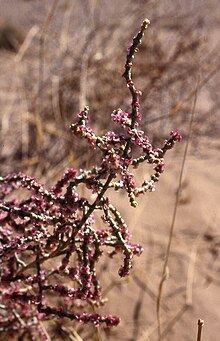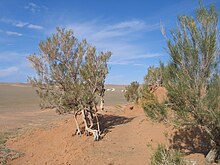Salsoloideae
| Salsoloideae | ||||||||||||
|---|---|---|---|---|---|---|---|---|---|---|---|---|

Anabasis articulata , tribe Salsoleae |
||||||||||||
| Systematics | ||||||||||||
|
||||||||||||
| Scientific name | ||||||||||||
| Salsoloideae | ||||||||||||
| Ulbr. |
The Salsoloideae are a subfamily in the foxtail family (Amaranthaceae). They used to be part of the goosefoot family (Chenopodiaceae).
description
Among the Salsoloideae include herbaceous plants , half-shrubs , shrubs and some trees . Stems or leaves are often succulent . The seed contains a spiral embryo . In most genera, the bloom cladding sheets form membranous wings at the fruiting time, which enable the fruit to spread through the wind ( anemochory ).

A characteristic of tribe Caroxyleae is that the anthers have a bubble-shaped, color-contrasting appendage at the tip, which probably attracts insects to pollinate . In Tribus Salsoleae this appendage is missing or is very small and of the same color as the anthers.
Photosynthetic pathway
The Salsoloideae are C 4 plants (apart from a few exceptions among the Salsoleae). While in the Caroxyleae only C 4 of the NAD malate enzyme type occurs, in the Salsoleae mostly the NADP malate enzyme type is found .






distribution
The subfamily Salsoloideae has its focus on biodiversity (center of diversity ) in the deserts and semi-deserts of Central Asia and the Middle East. Their distribution extends to the Mediterranean and Central Europe , to North and South Africa and to Australia , some species have also been introduced in the New World. Many species grow in very dry habitats ( xerophytes ) or tolerate salty soils ( halophytes ), some are ruderal plants .
Systematics
The type genus of the subfamily Salsoloideae is Salsola L.
Molecular biological investigations showed that the previous classification according to morphological properties did not reflect the phylogenetic relationship and therefore made a new classification necessary (the Camphorosmeae are now separated as a separate subfamily Camphorosmoideae .)
The subfamily Salsoloideae is divided into two tribes and contains about 35 genera:
- Tribe Caroxyleae Akhani & EHRoalson (as Caroxyloneae):
- Caroxylon Thunb. : With about 43 species.
- Climacoptera message . : With about 6-41 species.
-
Halarchon Bunge : With the only kind:
- Halarchon vesiculosum (Moq.) Bunge : It occurs in Afghanistan.
- Halimocnemis C.A.Mey. (Syn. Gamanthus Bunge , Halanthium C. Koch , Halotis Bunge ): With about 27 species that occur from Europe to Central Asia.
- Halocharis Moq. : With about seven species; they occur from West to Central Asia.
- Kaviria Akhani & EHRoalson : With about ten species.
- Nanophyton Less. : With about ten species that occur from Europe to Central Asia.
-
Ofaiston Raf. : With the only kind:
- Ofaiston monandrum (Pall.) Moq. : It occurs from southern Russia to Central Asia.
- Petrosimonia Bunge : With about twelve species that occur from Southeast Europe to Central Asia.
-
Piptoptera Bunge : With the only species:
- Piptoptera turkestana Bunge : It occurs in Central Asia.
-
Physandra Botsch. : With the only kind:
- Physandra halimocnemis (Botsch.) Botsch. : It occurs in Central Asia.
-
Pyankovia Akhani & EHRoalson : With the only kind:
- Pyankovia brachiata (Pall.) Akhani & E H. Roalson : It occurs in Central Asia.
- Tribe Salsoleae s. s.
- Anabasis L. (including Fredolia (Coss. & Durieu ex Bunge) Ulbr. ): With about 29 species that occur from the Mediterranean region to Central Asia.
- Arthrophytum Schrenk : With around nine species that occur in West to Central Asia.
- Cornulaca Delile : With about five kinds; they occur from Egypt to Central Asia.
-
Cyathobasis Aellen : With the only species:
- Cyathobasis fruticulosa (Bunge) Aellen : It occurs in Turkey.
- Girgensohnia Bunge ex Fenzl : With about four species; they occur from Europe to Central Asia.
- Halogeton C.A.Mey. (Syn. Agathophora (Fenzl) Bunge , Micropeplis Bunge ): With about five kinds; their homeland ranges from the Mediterranean to Central Asia.
- Halothamnus Jaub. & Spach : With around 21 species. They occur from the Middle East to Somalia and Afghanistan.
-
Saxaule ( Haloxylon ) Bunge : With only two types:
- Saxaul ( Haloxylon ammondendron (CAMey.) Bunge ex Fenzl ): It occurs in Central Asia.
- White Saxaul ( Haloxylon persicum Bunge ex Boiss. & Bunge ): It occurs in Central Asia.
- Hammada Iljin : With about twelve species.
- Horaninovia fish. & CAMey. : With about six species that occur in West and Central Asia.
-
Kali Mill .: With about 13 species, including:
- Ruthenian saltwort , steppe runner ( Kali tragus (L.) Scop. )
- Potash brine ( Kali turgida (Dumort.) Guterm. )
- Lagenantha Chiov. (Syn .: Gyroptera Botsch. ) (Assignment questionable): With one to three species that occur in northeastern Africa.
- Noaea Moq. : With about three types; they occur from Europe to West Asia.
-
Nucularia Batt. (Assignment questionable): With the only type:
- Nucularia perrinii Batt. : It occurs in Algeria and in the Sahara.
-
Rhaphidophyton Iljin : With the only species:
- Rhaphidophyton regulii (Bunge) Iljin : It occurs only in Central Asia.
- Salt herbs ( Salsola L. , Syn. Darneilla Maire & Weiller , Fadenia Aellen & Townsend , Neocaspia Tzvelev , Hypocylix Wol. , Seidlitzia Bunge ex Boiss. ): With about 25 species.
-
Sympegma Bunge : With the only kind:
- Sympegma Regelii Bunge : It occurs in Central Asia.
- Traganum Del. : With about two types. They occur in northern Africa and the eastern Mediterranean area.
-
Traganopsis Maire et Wilczek : With the only species:
- Traganopsis glomerata Maire & Wilczek : It occurs in Morocco.
- Turania Akhani & EHRoalson : With around four species.
- Xylosalsola Tzvelev : With about four types.
- Systematic position within the Salsoleae unclear:
- "Canarosalsola":
- Salsola divaricata Masson ex Link
- "Collinosalsola":
- Salsola arbusculiformis Drob.
- Salsola laricifolia Turcz. ex Litw.
- "Oreosalsola":
- Salsola abrotanoides bunge
- Salsola botschantzevii Kurbanov
- Salsola flexuosa botsch.
- Salsola junatovii Botsch.
- Salsola lipschitzii botsch.
- Salsola maracandica Iljin
- Salsola masenderanica botsch .
- Salsola montana Litw.
- Salsola oreophila botsch.
- Salsola tianschanica Botsch.
- Other types:
- Salsola genistoid juss. ex Poir.
- Salsola pachyphylla botsch.
- Salsola webbii Moq.
- "Canarosalsola":
- Systematic position within the Salsoloideae unclear:
-
Iljinia Korovin ex Kom .: With the only species:
- Iljinia regulii (Bunge) Korovin ex Kom .: It occurs in Central Asia.
-
Iljinia Korovin ex Kom .: With the only species:
swell
- Hossein Akhani, Gerald Edwards, Eric H. Roalson: Diversification Of The Old World Salsoleae sl (Chenopodiaceae): Molecular Phylogenetic Analysis Of Nuclear And Chloroplast Data Sets And A Revised Classification. In: International Journal of Plant Sciences. Volume 168, No. 6, 2007, pp. 931-956.
Individual evidence
- ↑ Vladimir I. Pyankov, Hubert Ziegler, Alexander Kuz'min, Gerald E. Edwards: Origin and evolution of C4 photosynthesis in the tribe Salsoleae (Chenopodiaceae) based on anatomical and biochemical types in leaves and cotyledons. In: Plant Systematics and Evolution. Volume 230, No. 1-2, 2001, pp. 43-74, DOI: 10.1007 / s006060170004 .
- ↑ a b c Hossein Akhani, Gerald Edwards, Eric H. Roalson: Diversification Of The Old World Salsoleae sl (Chenopodiaceae): Molecular Phylogenetic Analysis Of Nuclear And Chloroplast Data Sets And A Revised Classification. In: International Journal of Plant Sciences. Volume 168, No. 6, 2007, pp. 931-956, DOI: 10.1086 / 518263 .
- ↑ Gudrun Kadereit, Helmut Freitag: Molecular phylogeny of Camphorosmeae (Camphorosmoideae, Chenopodiaceae): Implications for biogeography, evolution of C4-photosynthesis and taxonomy. In: Taxon. Volume 60, No. 1, 2011, pp. 51-78, abstract .
- ↑ a b c d e f g h i j k l m n o p q r s t u v w x David John Mabberley: Mabberley's Plant-Book. A portable dictionary of plants, their classification and uses . 3rd ed. Cambridge University Press 2008. ISBN 978-0-521-82071-4

